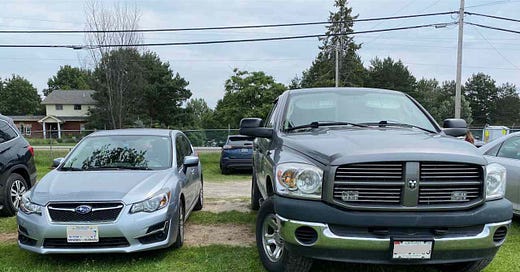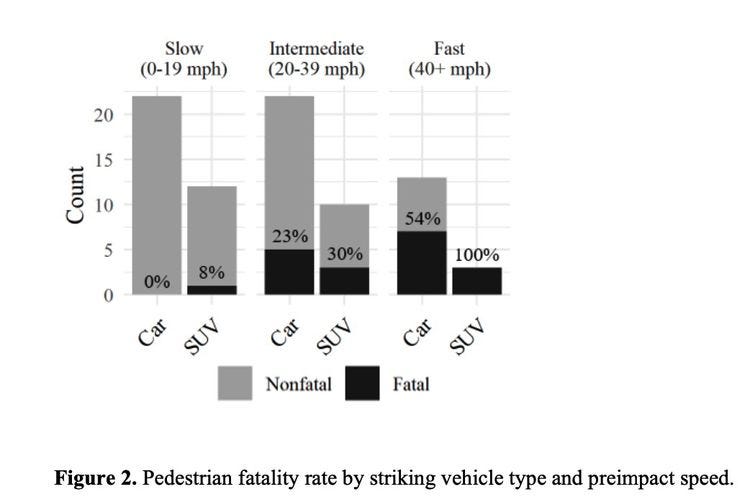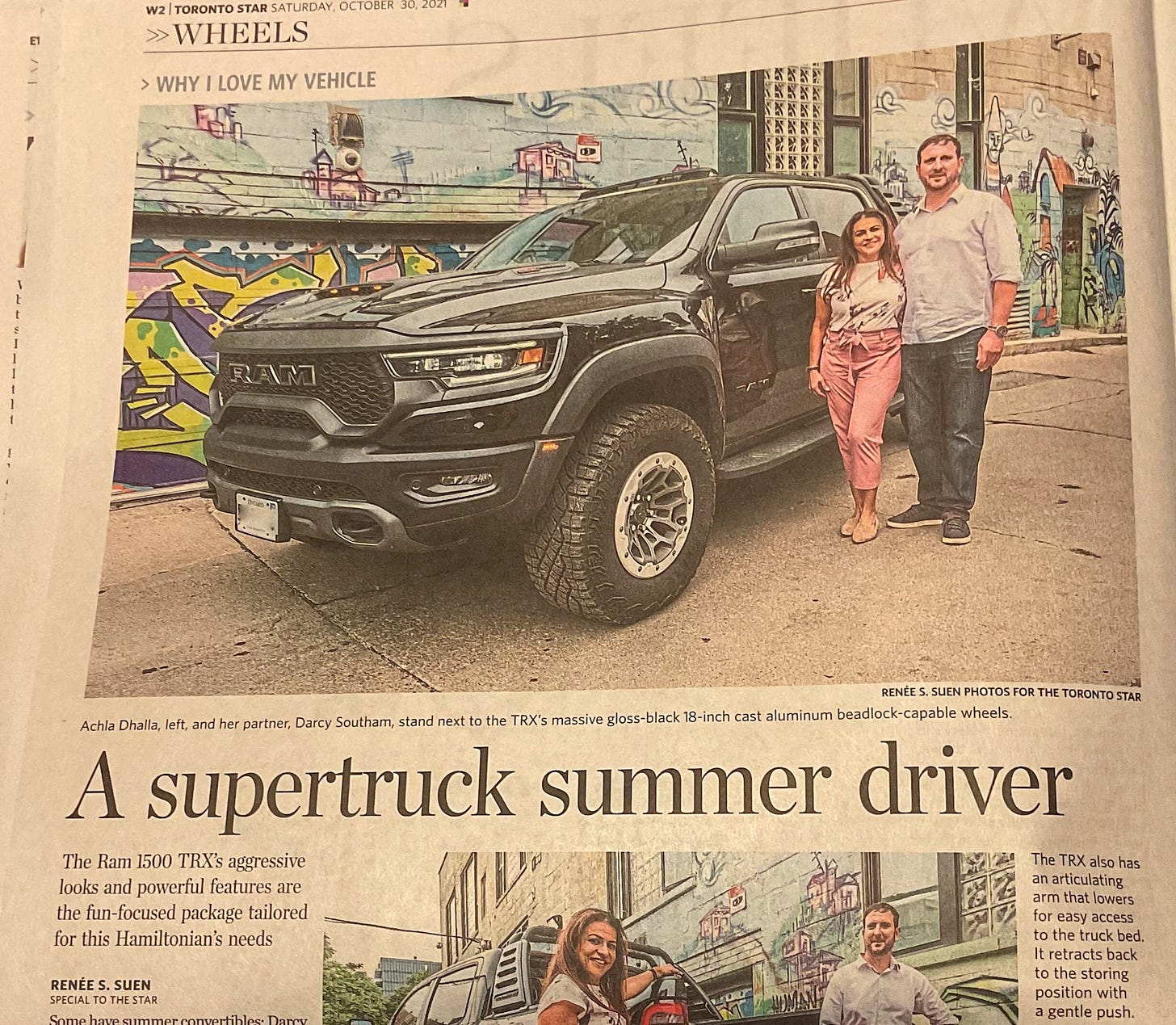It's time for limits on truck and SUV size and weight
They take up too much space, and they kill far too many pedestrians and cyclists.
It’s summer and every time we go to the farmers’ market, We are surrounded by monster trucks; our little Subaru is dwarfed. I must stand behind it to guide Kelly out of the space because she can’t see over the bed of the truck.
About the only driving I do is to the LCBO and Robinson’s General Store in Dorset, and I often find myself beside a truck that can’t seem to fit between the yellow lines.
This Shelby F-150 just pulled in as we were leaving the mall in Huntsville, and it is the biggest thing I ever saw. A tiny woman climbed out of it, I don’t know how she did it without a stepladder. According to the Shelby website, it has a 395HP, 5.0L V8 engine that can be supercharged to over 770HP. “This Shelby truck has room for everyone and everything to make you feel like the king of the world behind the wheel.” It starts at US$ 103,625. It dwarfed the Silverado and the pickup in front of it; definitely, it was the king of the parking lot.
One of the many reasons I said goodbye to my Miata a few years ago was that I didn’t feel safe among the F-150s. Now I am feeling that way in the Subaru. And apparently, for good reason; a recent report from the Insurance Institute for Highway Safety (IIHS) says:
A bigger, heavier vehicle provides better crash protection than a smaller, lighter one, assuming no other differences between them. The part of the vehicle between the front bumper and the occupant compartment absorbs energy from crashes by crumpling. As a result, longer front ends offer better protection in frontal crashes. Heavier vehicles also tend to continue moving forward in crashes with lighter vehicles and other obstacles, so the people inside them are subject to less force.
This bizarre graph from the IIHS shows that the more real estate that the vehicle covers (the X axis is the area of the truck in square feet!), the lower the rate of death of the drivers. The graph shows that the newest trucks are not as deadly as older ones because of design changes like energy-absorbing structures, but still:
In 2013-16, car occupants were only 28 percent more likely to die in collisions with SUVs than with cars, compared with 59 percent in 2009-12. Although pickups are also less of a threat than they used to be, in 2013-16 they were still 2½ times as likely to kill the driver of a car they crashed into, compared with a car colliding with another car.
The IIHS then discusses the tradeoff between weight and fuel economy, noting that “heavy vehicles tend to be safer than light vehicles.” Manufacturers are trying to make trucks lighter to increase fuel efficiency, but the IIHS suggests that electric trucks will save us because “the extra weight from their batteries can actually provide a safety boost.”
So now we have this vicious spiral where people are buying bigger and bigger trucks like this F-150 Tremor with “aggressive-looking matte-finish 18” wheels.” Because they feel safer.
Meanwhile, the pickups and SUVs do a great job of protecting people inside the vehicle, but are, according to another report from the IIHS, “disproportionately likely to injure and kill pedestrians compared with cars.”
Research has found that SUVs, pickup trucks, and passenger vans pose an outsize risk to pedestrians. Compared with cars, these vehicles (collectively known as LTVs) are 2-3 times more likely to kill the pedestrian in a crash. The elevated injury risk associated with LTVs seems to stem from their higher leading edge, which tends to impart greater injury to the middle and upper body (including the thorax and abdomen) than cars, which instead tend to cause injury to the lower extremities.
Another study found that people in big trucks drive faster, increasing the severity of injuries.
"..when viewing the road from a high eye height, drivers drove faster, with more variability, and were less able to maintain a consistent position within the lane than when viewing the road from a low eye height.... drivers choose to drive faster when they view the road from an eye height that is representative of a large SUV compared to that of a small sports car."

Yet another study from the IIHS found that drivers of pickup trucks turning left were four times as likely to kill as a regular car, three times as likely with vans, and twice as likely with SUVs. With right turns, pickups were 89% more likely to kill. The reason is that the A-pillars, between the windshield and the door, have to be beefed up to support the 3 tons of vehicle in a rollover, once again a feature protecting the driver with not such a terrific effect on the pedestrian:
“It’s possible that the size, shape or location of the A-pillars that support the roof on either side of the windshield could make it harder for drivers of these larger vehicles to see crossing pedestrians when they are turning,” says IIHS Senior Transportation Engineer Wen Hu.
In a remarkable paper, John F. Saylor nailed the problem of competing interests. It is in the consumer, or driver's interest, to have a heavier and higher vehicle "since vehicle height and weight negatively correlates with increased pedestrian safety and crash compatibility but positively correlates with increased occupant protection."
Last but not least, the Governors’ Highway Safety Association (GHSA) recently complained that Drivers Hit and Killed More Than 7,500 Pedestrians Last Year, Most Since 1981. They suggest a number of reasons but note that “over the past decade, the number of pedestrian deaths in crashes involving sport utility vehicles (SUVs) increased at a far faster rate (120%) than deaths in crashes involving passenger cars (26%). Because of their greater body weight and larger profile, SUVs and other light trucks can cause more harm to a person on foot when a crash occurs.”
I am nervous every time I write about pickup trucks. Last year, after seeing a Euro-style Ford Transit parked next to a Silverado in North Bay, Ontario, I wrote on Treehugger: A Tale of Two Trucks: Why US Pickups Need European-Style Regulations and got a record 348 comments, mostly calling me an idiot, a “leftist looney that drives a Subaru,” and blaming pedestrians for looking at cellphones or wearing hoodies. I’m hoping they won’t find me on Substack! A favourite:
“A non truck user telling a truck user what he/she should or shouldn’t drive, how disgusting, walkers and cyclists both need to understand that they do not own the roads, and neither of them pay fuel taxes. And those European trucks are FUGLY.
European mindset has destroyed our streets with those ugly, useless, unsafe roundabouts, now they come for our trucks. They should just drink lattes and eat cookies and tea.”
Some of the commenters had more sensible arguments; there are some practical reasons, depending on where you live. Up here, just about every vehicle is a pickup or a Subaru. There is a lot of snow, they put on a lot of miles and use their trucks as working vehicles. Many drivers worry about hitting deer or moose, a legitimate concern. But do they have to be so big?
Here is a working truck that is often parked in our neighbourhood. It’s not much bigger than the Volvo behind it, and it can probably fit a sheet of plywood in its bed. None of these fancy new trucks can carry a 2x4.
They do not belong in the city. They shouldn’t be marketed with “aggressive looks” where the owner barely comes up to the side mirror.
These are not working vehicles. It doesn’t snow much in the city, and I haven’t seen a live moose downtown in many years. It’s time to tax them, or as I have written, make them as safe as cars or ban them from cities. In one Montreal borough, they are doing something about this and charging more for parking.
“Bigger cars are more dangerous, and they take a toll on the infrastructure, on the roads,” borough Mayor François Limoges said in an interview. “As a borough, our power is on the parking. So we decided to send a message that bigger cars have a price.”
The price we all pay for having these on our streets is not just money, it’s also paid in lives.














Well said, Lloyd. As a contractor, I've been driving trucks for 4 decades and have experienced first-hand the inflation in trucks size. The current F-150 dwarfs one from the 80's or 90's. In fact Ford now has a "maverick" that's about the size of an old F-150. I had to get a screw-on ladder for the tailgate of my most recent truck because it's so high off the ground I could no longer easily climb in (and I'm 6' tall).
I'm always amazed when I see trucks that clearly are mostly commuter vehicles. My current fleet (a Silverado 1500 and an F-250) get about 16 and 12 mpg, respectively. I would never drive a truck if i didn't have to. A vehicle useless for anything but hauling shit around.
And the reactions you get show how much driving these stupid behemoths are seen as lifestyle signifiers more than anything else. Every SUV ad seems to show them somewhere where no vehicle should be - the conquest of nature is always the subtext in the marketing. Even if a soccer field is as close as the vehicle ever gets to off-road.
A former next door neighbor once said "Big truck, small dick."